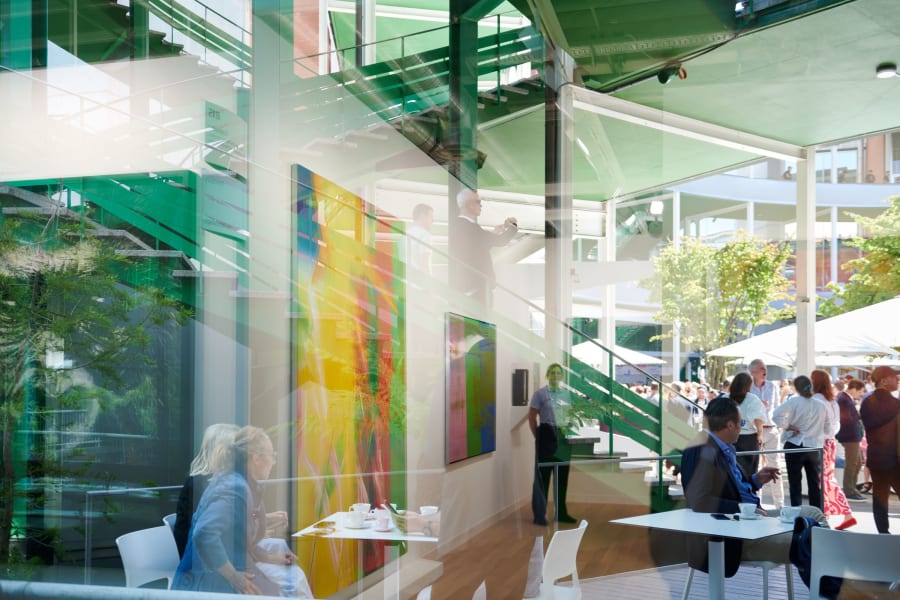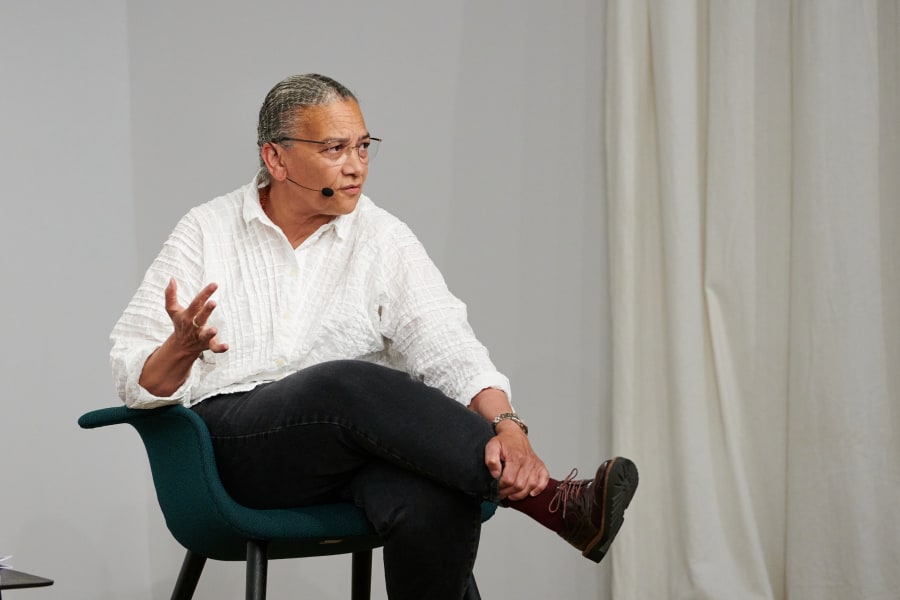Art Basel isn’t only an event for galleries – it is also an event by galleries. That applies to both its genesis – it was founded in 1970 by Ernst Beyeler, Trudl Bruckner, and Balz Hilt, three Basel-based art dealers – and its current set-up.
The exhibitors at Art Basel’s shows in Basel, Paris, Miami Beach, and Hong Kong are not chosen by Art Basel’s directors. They are not picked by a jury of curators or patrons. Instead, each fair has a selection committee – composed of gallerists, themselves. But how did this come to be?
As Art Basel has grown in size and importance, the numbers of galleries vying for spots at its four fairs have skyrocketed: At the oldest fair in Basel, gallerists from six continents and across all sectors of the art market apply for just under 300 spots. They perfect online applications nine months ahead, carefully choose artists to exhibit, and mock up intricate virtual booths.
To whittle down the field, each Art Basel fair has a primary selection committee of six to eight members. Further experts – who are likewise art dealers – determine who shows in project-based sectors such as Statements in Basel and Emergence in Paris, which highlight works by young artists mounted by young gallerists, or Survey in Miami Beach, which foregrounds artistic practices of historic relevance. While galleries applying to Art Basel's main sector are evaluated on the overall quality and strength of their program, submissions for the project-based sectors are judged exclusively on the basis of the proposed project.
As arduous and nerve-racking a process as it is for a gallery seeking admittance, it can be just as weighty for a selection committee member. ‘It’s difficult, and the applications are many,’ says Prateek Raja, an Art Basel in Basel selection committee member and co-owner, with his wife Priyanka Raja, of Experimenter gallery in Kolkata and Mumbai in India.
Because of the strict confidentiality that has come to define their meetings, committees carry their own mythology, shrouded in a sort of austere mystery. But ultimately the goal of the committees is to assemble the best fair as impartially as possible. ‘It’s not magical. There’s a tremendous level of debate over many days, and a lot of very important and nuanced conversations,’ says Clément Delépine, director of Art Basel Paris, about the selection committee for Paris. ‘The entire field of art is rooted in subjectivity, but what the selection committee talks about is how important they think a particular gallery or artist’s presence is at the fair.’
‘We know galleries put their best foot forward when they prepare their application - which is also why they are all examined thoroughly, year after year, regardless of a gallery’s status or history with the show’ adds Vincenzo de Bellis, Art Basel's Director of Fairs and Exhibition Platforms. Keeping a spot isn’t a given – on-site evaluators check booths’ appearance and quality, how much the art on view changes from day to day, and compare notes. Previous exhibitors must reapply each year, and it’s important to always develop and evolve. Resting on laurels is not an option.
It wasn’t always this way. In the 1970s, Art Basel was a group of galleries gathering each spring in what, at the time, was an avant-garde art-market experiment. An advisory board consisting of participating gallerists emerged late in that decade as the art market began to expand: Its earliest iteration consisted of about 25 dealers.
This shifted during a crisis in the early 1990s, when the Swiss fair had outgrown its former parameters. In 1993, which many consider a turning point in Art Basel’s evolution, problems like a disorganized layout and disappointing sales resulted in disgruntled dealers asking for refunds. Then-director Lorenzo Rudolf led a team that revamped the fair’s layout introducing wider aisles and a standardized booth size: a ‘revolution’ that in some ways marks the genesis of art fairs as we know them today. Rudolf also established a selection committee, and Art Basel has had a peer-committee system ever since.
The eight members of the Art Basel in Basel committee meet multiple times throughout the year to debate and discuss: ‘I spend a total of four to six weeks each year on the selection committee,’ says Raja. For Art Basel Paris, a smaller fair with just under 200 booths, the process is more concentrated, and usually happens in one intense go – ‘about a week-long in total,’ explains Florence Bonnefous, the co-founder of Air de Paris gallery in Paris. Bonnefous has been on the selection committee for Art Basel Paris since its inception in 2022, but also served on the committee for Art Basel in Basel under Sam Keller’s tenure at Art Basel in the early 2000s.
Meetings can get intense. ‘When committee members debate, there’s a lot of productive tension,’ notes Delépine. According to Bonnefous, members pre-read the applications, then read them again as a group, viewing PDFs, SketchUp presentations, and Excel sheets together and sometimes arguing hard for a specific position. Sector selections start as recommendations from specially appointed experts, but are always voted on by the main committee as well.
Big surprises can arise: ‘The Emergence and Premise sectors are project-based, so sometimes a presentation from a young gallery is so impressive that voting takes one second,’ explains Delépine, who’s seen the hands of an entire committee shoot up in assent. ‘The room is filled with excitement.’ Other times, debates drag and swing this way and that. ‘Sometimes you spend so much time on one application: There may be an argument in favor of a gallery, and then you see a vote shifting from six against to one in favor, then from five to two, to ultimately seven in favor.’
More than 50 years after its inception, is Art Basel’s peer-driven selection procedure still effective? Delépine likens it to democracy – imperfect, but far better than other systems. ‘It’s an exercise in collective intelligence and what the selection committee members care about is the integrity of the fair,’ he says. Bonnefous says it’s not always easy to choose who gets in and who doesn’t. ‘I don’t lose my objectivity, but sometimes a decision is heartbreaking,’ she says. While Raja remembers what it was like being on the outside: ‘When we were just a gallery applying, it was quite difficult for me to appreciate and understand why another gallerist could be responsible for judging my program,’ he says. ‘But when you're on the selection committee, you quickly realize how robust a process it is. It has several checks and balances in place, and we constantly deliberate and debate among ourselves before making our decisions. The selection process has been carefully developed over the years with fellow gallerists - past and current committee members - who are deeply concerned, acutely aware, and thoughtful about the spectrum of galleries who apply to the fair. I can vouch for the integrity of each one of my colleagues in the committee. They’re true gallerists, a group of extremely passionate and righteous people, guided by conscience and reason.’
Who makes it onto a committee? Raja was approached years ago by Marc Spiegler, the Global Director of Art Basel until 2022, and stayed on when Noah Horowitz became CEO. Art Basel Paris brought a different procedure into play: Five of the seven members came from the former FIAC jury, including Bonnefous, and their institutional knowledge and connections in the French scene have proven invaluable.
Most selection committee members stay five to ten years, and choosing new ones is delicate. ‘You need someone who’s willing to debate, willing to think against themselves, and able to listen,’ says Delépine. ‘You want to also consider people who have a broad understanding of the market, and not simply their own niche; people who understand what it means to put a great fair together, and who are seen as anchors within the industry and respected by their peers.’
Seen from the other side, Raja explains that despite the role’s time commitment and deep responsibility, part of why he serves on it is curiosity and collegiality. ‘I think most of us are in it because we are kind of craving to know more about what our colleagues are doing and feel connected to their practices as fellow gallerists who are on a journey with their artists, much like we are with our own,’ he says.
‘Maintaining balance and high standards and promoting contemporary art on a global scale is neither simple nor straightforward, and Art Basel’s selection procedures are committed to evolving with the times,’ de Bellis notes. The list of committee members for each fair are available on Art Basel’s website, and the committees recently grew in size, from six to seven or eight. For the Basel fair, there’s an appeals procedure for galleries who would like to contest an unsuccessful application. Since the COVID-19 pandemic, Art Basel has also adjusted its eligibility criteria for exhibitors, with galleries no longer needing to be in existence for a certain number of years or having a dedicated physical space to apply.
‘Supporting promising younger and excellent mid-career gallerists in these competitive times has become crucial for Art Basel,’ de Bellis adds. Often, galleries start by showing work in the project-based sectors in the fair’s different locations; if the selection committee is fully convinced of a gallery’s potential for longevity and programmatic coherence, they will encourage it to apply to the main sector the next year, fostering upwards mobility (although with no guarantees). However, this isn’t a prerequisite for participation in Art Basel’s prestigious main Galleries sector: Five first-time exhibitors are entering directly in the main sector of this year’s edition of Art Basel in Basel, where they can exhibit the full range of their programs.
And, as the art-historical canon deepens and broadens, Art Basel, too, expands its scope, seeking galleries from outside art’s traditionally Eurocentric centers and thus creating a more vigorous global network on all sides of the selection procedure. Raja was the first committee member for the main fair in 50 years of Art Basel from the east of Berlin; the organization also builds on its selection committees' geographical reach and cumulative experience to create a more representative selection of galleries at its shows. As Vincenzo de Bellis puts it: ‘Our goal is to create a framework that benefits our exhibitors and constantly evolving audiences, whether they hail from New York, Jakarta, or Cape Town. With four shows and clients across six continents, we work hand in hand with leading experts in the fields of arts and culture to achieve this. The gallerists sitting on our Selection Committees are without a doubt among them.’
Art Basel in Basel runs June 13-16, 2024. Buy your tickets here and find out more here.
Kimberly Bradley is a writer, editor, and educator based in Berlin. She is Art Basel in Basel's Conversations curator and commissioning editor at Art Basel Stories.
Caption for top image: a view of Art Basel in Basel 2022.
Published on June 7, 2024.


